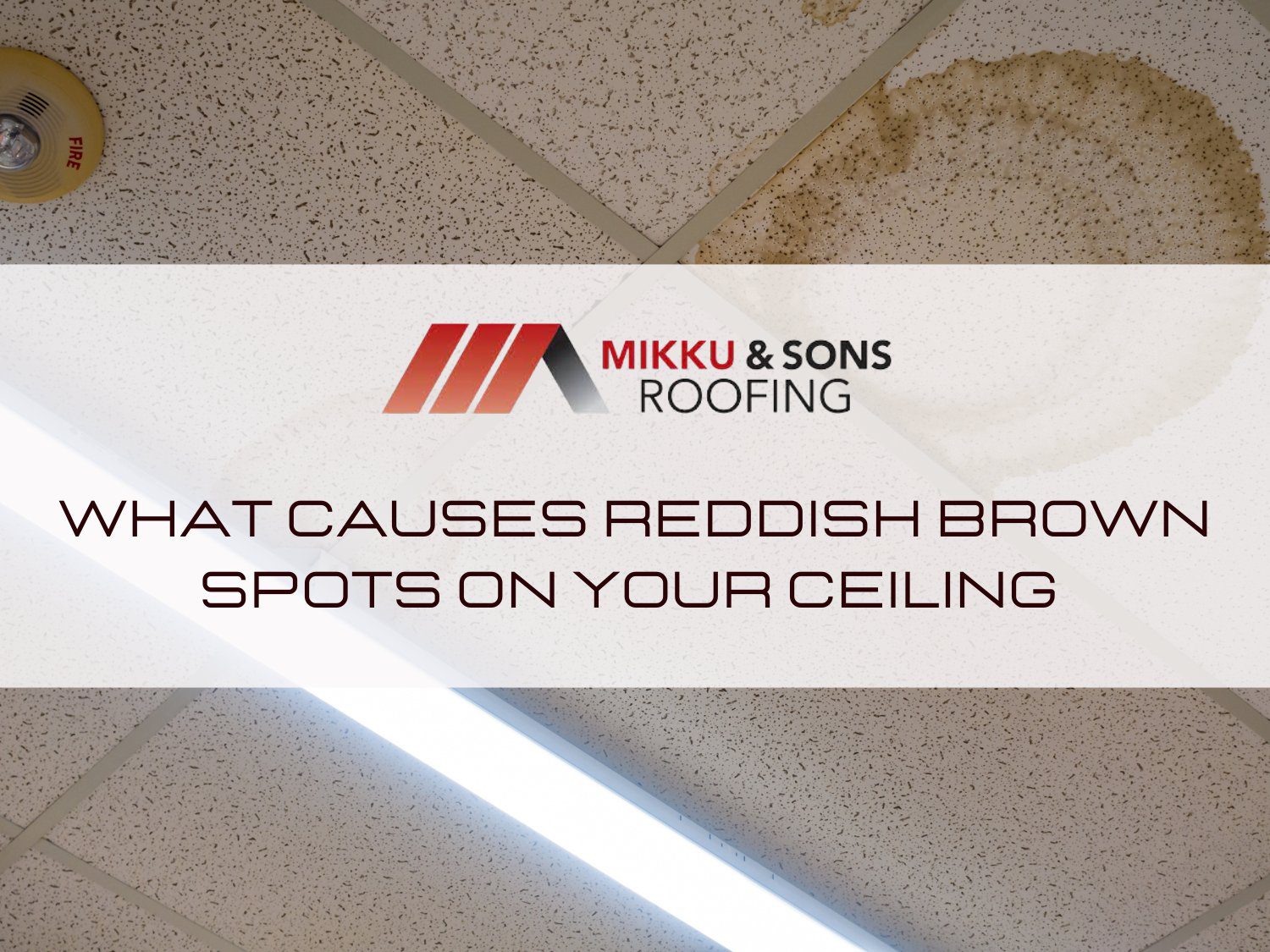

Ever glance up and spot an unwelcome guest? Reddish brown spots on your ceiling? It's more than just an eyesore; it's your home's way of whispering, "Something's not right!" These spots can be mysterious, hinting at hidden plumbing leaks, roof vulnerabilities, or even sneaky mold lurking above.
Ignoring them is like ignoring a cough – it might get worse. So, let's unravel the mystery behind those spots. We'll explore common causes, from water damage to unexpected sources, and equip you with practical fixes to reclaim your ceiling and ensure a healthy home!
Reddish-brown spots on your ceiling are a sign of water damage, often caused by roof leaks, plumbing issues, or high humidity. Ignoring these stains can lead to mold growth, structural damage, and costly repairs. Identifying the cause early can prevent more serious problems.
Reddish-brown stains on your ceiling are a clear sign that something is wrong. These stains don’t just ruin the look of your home—they indicate potential water damage, leaks, or mold issues. Understanding the root cause is essential to fixing the problem before it gets worse.
Reddish-brown stains on your ceiling are more than just an eyesore—they signal an underlying issue that needs attention. Before you can fix the problem, you need to identify where the stains are coming from. Pinpointing the source early can prevent costly damage and potential health risks.
If the stain is located near the center of a room or along an exterior wall, a roof leak might be the cause. Damaged shingles, cracked flashing, or clogged gutters can allow water to seep into your home. Over time, this moisture collects in the ceiling, leading to discoloration and potential structural damage.
To check for a leak, look for missing, cracked, or curled shingles on your roof. Inspect your attic for wet insulation or water drips after rainfall. You should also examine the roof flashing around vents, chimneys, and skylights for gaps or damage that may be allowing water to seep through.
Ceiling stains beneath a bathroom or kitchen often point to a plumbing leak. A slow, hidden leak from a pipe or fixture can cause significant moisture buildup over time. Even small leaks can create persistent staining, weaken the ceiling material, and lead to mold growth.
To check for plumbing issues, look for water spots directly under sinks, toilets, or bathtubs. Check exposed pipes for condensation or drips. You can also run water in upstairs fixtures and monitor if new stains appear on the ceiling below.

If the stain appears in areas with metal pipes, nails, or ductwork, rust could be the culprit. Rust forms when metal is exposed to moisture over time, causing brownish discoloration to seep through the ceiling. This is common in older homes with outdated plumbing or HVAC systems. If you suspect rust stains, inspect metal pipes and fasteners above the ceiling for signs of corrosion.
Poor ventilation can lead to condensation buildup, especially in humid rooms like bathrooms, kitchens, and attics. Excess moisture from everyday activities can collect on ceilings and walls, leading to stains. If a room has high humidity levels, condensation may be forming on cooler ceiling surfaces and causing discoloration.
To check for condensation problems, inspect areas with poor airflow for signs of mildew or peeling paint. Ensure exhaust fans are working properly in bathrooms and kitchens to remove excess moisture. If the problem persists, check attic ventilation to prevent moisture buildup.
If the stain has a musty smell or continues to grow, mold could be the issue. Mold thrives in damp environments and can cause brown, black, or reddish stains on ceilings. Mold exposure can also trigger allergies and respiratory issues, making it a serious concern for indoor air quality.
To identify mold problems, use a flashlight to inspect the stained area for fuzzy or speckled textures. Check for additional mold growth on walls, vents, or insulation. If mold is present, it’s important to address both the stain and the moisture problem causing it.
Reddish-brown stains on your ceiling aren’t just unsightly—they’re a sign of an underlying issue. Before you can remove the stains, you need to fix the root cause to prevent further damage.
Whether the stains are caused by a roof leak, plumbing issue, or condensation, here’s how to address them effectively.
Before cleaning or repainting, you must stop the issue that’s causing the stains. If you don’t fix the source, the stains will keep coming back.
If the problem is a roof leak, check for missing shingles, damaged flashing, or clogged gutters. Any roof damage should be repaired immediately to prevent further water infiltration. For plumbing leaks, inspect pipes above the ceiling for drips or moisture.
Tightening fittings or replacing damaged pipes can stop the issue before it worsens. If condensation is the problem, improve ventilation in humid areas like bathrooms and kitchens by using exhaust fans, dehumidifiers, or attic vents.
Once the source of the moisture is fixed, drying the ceiling thoroughly is the next crucial step. Trapped moisture can lead to mold growth and further ceiling damage. Use fans or a dehumidifier to remove excess moisture and speed up the drying process.
If the ceiling material is severely waterlogged, it may need to be cut out and replaced with fresh drywall. Ensuring the ceiling is completely dry before moving to the next step will prevent mold and mildew from forming.
After the ceiling is dry, you’ll need to remove the discoloration. The cleaning method depends on whether the stain is caused by rust, mold, or water damage. For water stains, mix equal parts bleach and water, then gently scrub the area with a sponge to lift the stain.
Rust stains can be treated with a vinegar or rust remover solution before wiping them clean. If mold or mildew is present, use a mold-killing cleaner or a mixture of bleach and water to eliminate spores and prevent regrowth.
Once the stain is cleaned, apply a high-quality stain-blocking primer to the affected area. This prevents the stain from bleeding through when you repaint.
Choose a primer specifically designed for water stains, as it will provide a better seal. Allow the primer to dry completely before moving on to painting.
After priming, repaint the ceiling with a color that matches the rest of the room. Using mold-resistant or moisture-resistant paint in high-humidity areas can help prevent future issues. Applying at least two coats will ensure even coverage and restore the ceiling’s appearance.
Reddish-brown stains on your ceiling are a warning sign of underlying issues like leaks, mold, or rust. Fixing the problem is only half the battle—taking preventative measures will help ensure the stains don’t return. Here’s how to protect your ceiling and keep your home in top shape.
Since roof leaks are a common cause of ceiling stains, regular roof maintenance is essential. Small cracks or missing shingles can allow water to seep in, leading to moisture buildup and discoloration. To prevent this, schedule roof inspections at least twice a year, especially after heavy storms.
Clear your gutters and downspouts to prevent water from pooling on the roof. Check for signs of damage like curled or missing shingles, cracked flashing, or sagging roof sections. If you notice any issues, repair them promptly to avoid leaks.
Plumbing leaks inside walls or ceilings can slowly create persistent stains. A small drip from a pipe or fixture can cause major damage over time. To prevent this, inspect pipes, faucets, and appliances regularly for leaks.
If your ceiling is beneath a bathroom or kitchen, check the plumbing connections for signs of wear. Look for damp spots, peeling paint, or unusual watermarks. If you suspect a hidden leak, hire a professional plumber to fix it before it worsens.
Excess moisture in your home can lead to condensation, which causes stains and mold growth. Proper ventilation helps control humidity levels and prevents moisture from settling on ceilings.
Make sure exhaust fans in bathrooms and kitchens are working efficiently. Open windows when cooking or showering to allow fresh air to circulate. If certain areas of your home remain damp, consider using a dehumidifier to reduce excess moisture.
If your home has metal pipes, nails, or HVAC ducts running through the ceiling, rust can be a problem. Moisture exposure over time can cause metal components to corrode, leading to brownish stains.
To prevent rust stains, ensure your home remains dry and well-ventilated. If you live in a humid climate, apply rust-resistant coatings on exposed metal surfaces. Replace old, corroded pipes or fittings before they cause further damage.
Mold thrives in damp conditions and can cause recurring stains. If you’ve had mold before, preventing its return is crucial for maintaining indoor air quality.
Keep your home dry by fixing leaks, improving ventilation, and using mold-resistant paint in humid areas. Clean and disinfect areas prone to moisture buildup, such as bathrooms, basements, and attics. If mold does appear, remove it immediately using a bleach solution or professional mold treatment.
Reddish-brown spots on ceilings often result from water intrusion, mold, or environmental factors. Common causes include roof leaks, faulty flashing, and leaking pipes.
To address these issues, inspect your roof for damaged shingles and ensure proper flashing. For plumbing leaks, check for worn-out pipes or clogs. After fixing the source, consider consulting our previous blog post on how to fix a leaking roof for comprehensive guidance on repairing roof-related problems.
